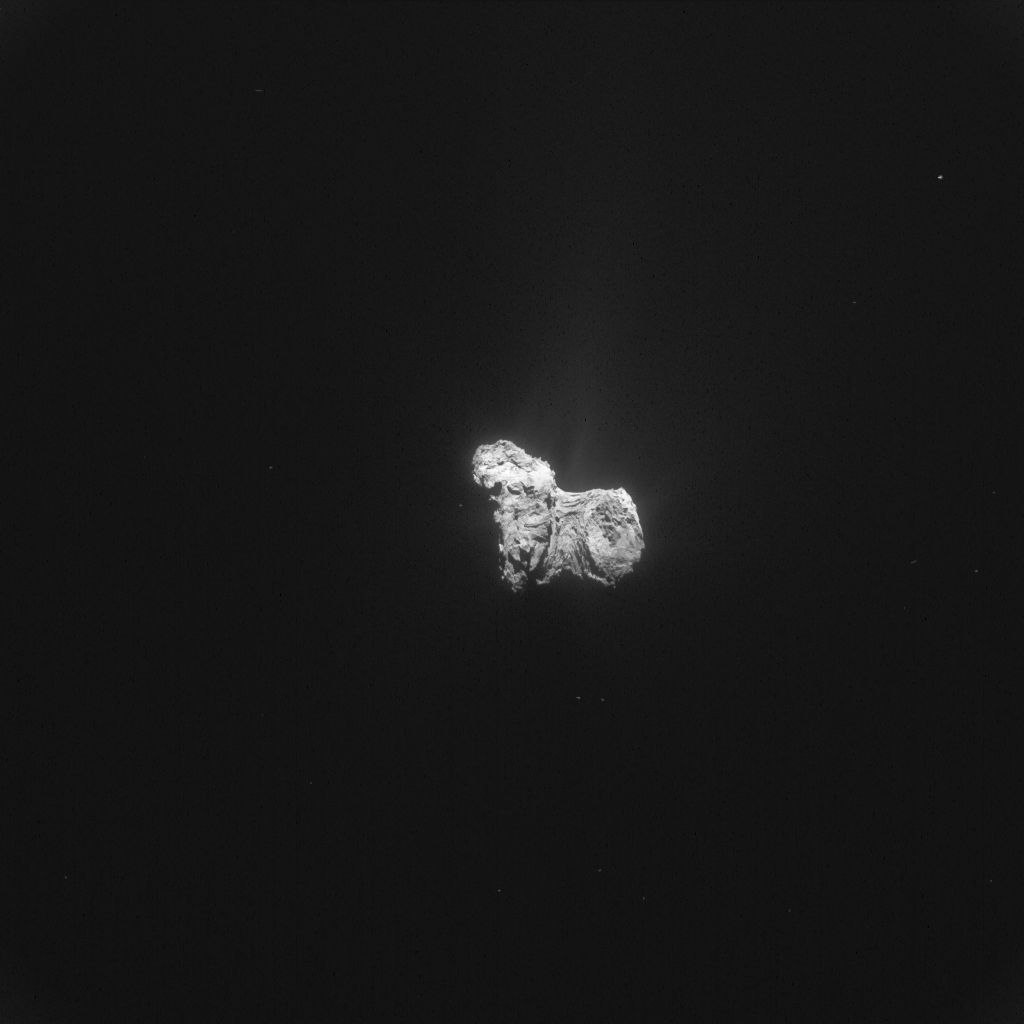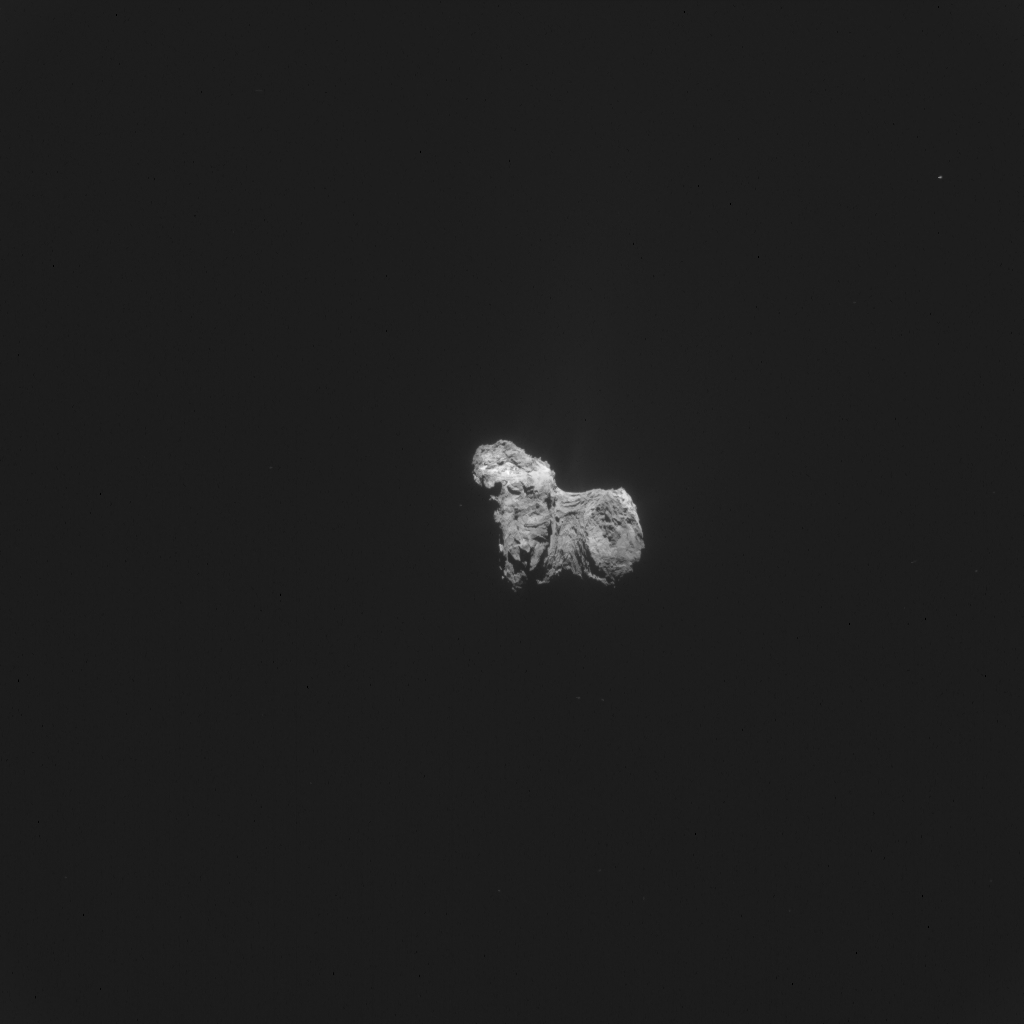Today’s CometWatch entry is a NAVCAM image taken on 31 October 2015, when Rosetta was 293.4 km from the nucleus of Comet 67P/Churyumov-Gerasimenko.
The scale is 25 m/pixel and the image measures 25.6 km across; the contrast was increased to bring out the comet’s activity.

Single frame enhanced NAVCAM image of Comet 67P/C-G taken on 31 October 2015. Credits: ESA/Rosetta/NAVCAM – CC BY-SA IGO 3.0
In this orientation, the comet small lobe is on the right and the large lobe on the left. The image shows interesting surface details of the four regions that were identified on the southern hemisphere after Rosetta started surveying this portion of the nucleus. The flat appearance of the Wosret region, on the small lobe, contrasts with the beautiful pattern of features seen on Sobek, in the ‘neck’ region. On the large lobe, parts of Anhur along with Khonsu are visible, while portions of two previously known regions, Anubis and Atum, can also be seen towards the top.
The original 1024 x 1024 image of today’s CometWatch is provided below:










Discussion: 15 comments
“The flat appearance of the Wosret region, on the small lobe, contrasts with the beautiful pattern of features seen on Sobek, in the ‘neck’ region.”
Agree, Emily 🙂
Small lobe appears a lot more ‘solid’.
Sobek surface brings a visual allegory of a sand clock.
Once my mind have decided preference for a model, everything ‘grows’ by itself around it. ‘Seeing’ the binary slowly creating a ‘sinter’ bridge. Then this bridge widening at both sides.
Just a few days into the cold and activity shows the hit:
https://www.esa.int/spaceinimages/Images/2015/09/Comet_on_30_August_2015_NavCam
Small lobe exhibits a minimal 20% ‘peeling’ in between those two shots.
Big lobe exhibits most dramatic change around:
https://blogs.esa.int/rosetta/2015/08/28/cometwatch-22-august-2/
The extremely different way both lobes react to Sun talks about them being substantially [or micro-structurally] not similar.
Small lobe is more planar, while Big lobe is more spheroidal.
Hi Emily and H. Navcam Team:
That big, dark spot at the left side of neck’s neck is situated at the frontier of 3 geological zones. Could it be related to the main ‘jet’ of Sobek?
As said before, Ram, can also perceive it. As progressive little steeps. [Not on my top list]. And also waiting for before/after differential measures 🙂
Even when coming, that would not exclude plausibility of a no more occurring process. That’s the beauty of ideas!
Should consider Teams are looking for models helpful on explaining this ‘binary’ frequency at small Objects.
Hi Logan,
Now reset your mind to stretch model just for a moment.
The widening sinter bridge of the neck: But now do you notice the Stretch marks and twist marks as they formed?
Small lobe is more planar while large Big lobe is more spheroidal: Yes… As it would be if only the head lobe lifted off the onion!
Etc…
I like your statement about once your mind has a preference everything grows around it.
Seeing is always a brain construct. Consider how many optical illusions can be seen two ways, the ugly old hag or the pretty girl?… The vase or the two faces?…
😉
“As it would be if only the head lobe lifted off the onion!”
That would bring more precedence to slab-icity than to plasticity. Am I wrong?
Have you considered an impact being the cause of the “head lobe lifted off the onion”? Where should it have occurred?
Hatmehit being the antipode of the impacting?
That would account for the ‘perfect’ trench-ness at certain perspectives of the neck, as signaled by Robin.
Hi Ram:
https://blogs.esa.int/rosetta/2015/11/13/video-science-highlights-one-year-since-comet-landing/
Check video from 2:01 to 2:10 min.
See this!:
https://scute1133site.wordpress.com/2015/11/12/67pchuryumov-gerasimenko-a-single-body-thats-been-stretched-part-28/
That yellow pointed strata talks of a very very big ‘onion’. Also could talk of no onions 😉
On thinking of this layering at Small Lobe, ‘Onion’ morphology could be limited to Coma Returns.
Could Scientists give arguments about our Sun being Ducky’s only Sun?
Was our Sun born alone? At a cluster?